| JANUARY 2022 |
| Cancellation of two Kabuki performances in January 2022 due to coronavirus (COVID-19)!!! |
|
6 shows in T˘ky˘ (Kabukiza, National Theatre,
|
| Kabukiza (T˘ky˘) |  |
| Dates | 2 ~ 27 January 2022 Kotobuki Hatsuharu ďkabuki Congratulation Early Spring Grand Kabuki |
| 1st Program |
|
| 2nd Program |
Haru no Kotobuki
Kantan Makura Monogatari (Rosei no Yume) |
| 3rd Program |
Arigataya Hana-ga-Tatsud˘ Ake no Kagekiyo |
| Casting |
Living National Treasure Nakamura T˘z˘, Nakamura Shikan, Nakamura Baigyoku, Nakamura Kaishun, Nakamura Jakuemon, Nakamura Ganjir˘, Nakamura Senjaku, Matsumoto K˘shir˘, Ichikawa Ennosuke, Kataoka Takatar˘, Nakamura Kinnosuke, Nakamura Kankur˘, Nakamura Shichinosuke, Nakamura Karoku, Nakamura Matagor˘, Ichikawa Monnosuke, Nakamura Shid˘, Onoe Matsuya, Band˘ Minosuke, Nakamura Hayato, ďtani Tomoemon, Ichikawa Komaz˘, Nakamura Yonekichi, Band˘ Shingo, Nakamura Kash˘, Nakamura Tanenosuke |
| Comments |
The three programs for the New Year Grand Kabuki at the Kabukiza.
|
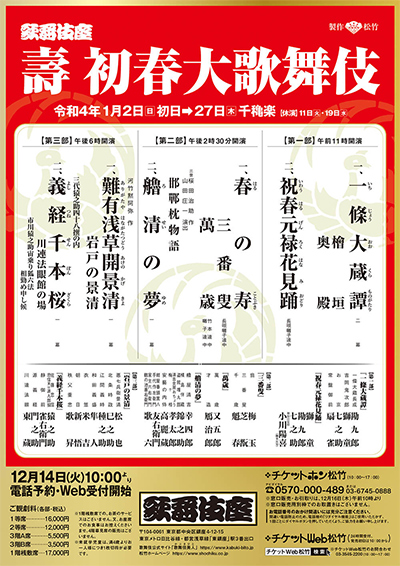 |
| National Theatre (T˘ky˘) |
| Dates | 3 ~ 27 January 2022 |
| Program | |
| Casting |
Living National Treasure Onoe Kikugor˘, Nakamura Tokiz˘, Onoe Kikunosuke, Onoe Sh˘roku, Band˘ Hikosabur˘, Ichikawa Sadanji, Ichikawa Danz˘, Band˘ Rakuzen, Ichimura Manjir˘, Kataoka Kamez˘, Kawarasaki Gonjűr˘, Band˘ Kamez˘, Nakamura Baishi, Nakamura Mantar˘, Ichimura Takematsu, Onoe Sakon, Ichimura Hikaru, Ichimura Kitsutar˘ |
| Comments |
The New year Kabuki performances at the National Theatre with a troupe led by Living National Treasure Onoe Kikugor˘.
|
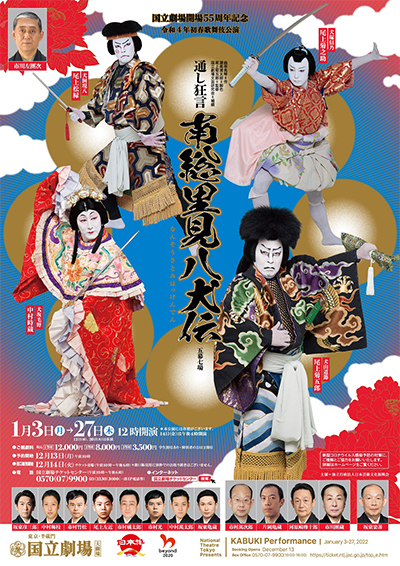 |
| Sh˘chikuza (ďsaka) |  |
| Dates | 2 ~ 23 January 2022 Band˘ Tamasabur˘ Hatsuharu Tokubetsu Buy˘ K˘en Band˘ Tamasabur˘ Early Spring Special Dance Performances |
| Program | |
| Casting |
Living National Treasure Band˘ Tamasabur˘ |
| Comments |
A special Buy˘ program at the Sh˘chikuza starring Living National Treasure Band˘ Tamasabur˘.
|
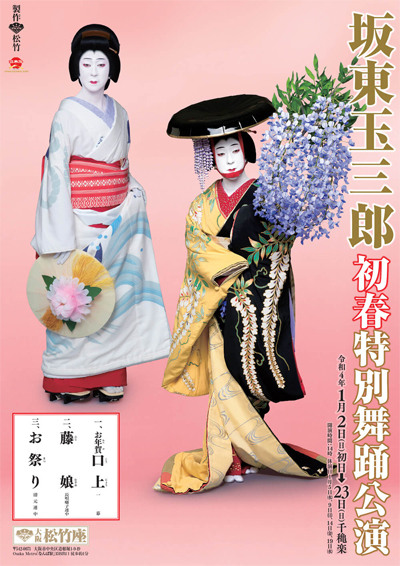 |
| Shinbashi Enbuj˘ (T˘ky˘) |  |
| Dates | 3 ~ Hatsuharu Ebiz˘ K˘en Early Spring Ebiz˘ Performances |
| Program | |
| Casting |
Ichikawa Ebiz˘, Ichikawa Udanji, Ichikawa Sai'nyű, Ichimura Kakitsu, Nakamura Kotar˘, Kataoka Ichiz˘, Ichikawa Omez˘, Ichikawa Kudanji, ďtani Hiromatsu, Horikoshi Kangen, Ichikawa Botan, ďchi Y˘suke |
| Comments |
The traditional New Year Kabuki at the Shinbashi Enbuj˘ with a troupe led by the young star Ichikawa Ebiz˘. They perform in a newly-created Kabuki drama entitled "Puperu", which is based on Nishino Akihiro's children's picture book "Poupelle of Chimney Town". This drama is directed by Fujima Kanjűr˘ VIII. |
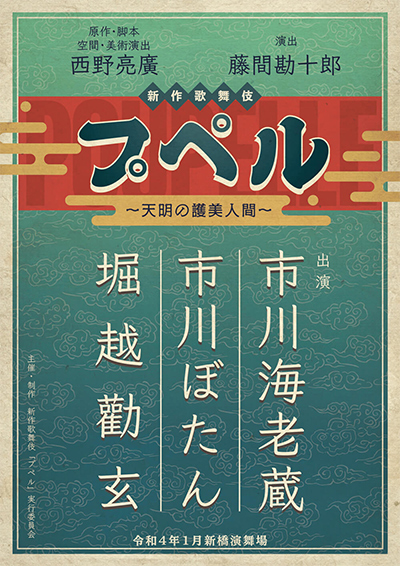 |
| Dates | Ichikawa Ebiz˘ Kikaku K˘en ~ IBUKI Ichikawa Ebiz˘ Project Performances ~ Breath |
| Program |
Haru no Shirabe Musume Nanakusa |
| Casting |
Nakamura Kotar˘, Ichikawa Kudanji, ďtani Hiromatsu, Ichikawa Shinz˘, Ichikawa Shinjűr˘, Nakamura Shinobu, Ichikawa Tsutanosuke, Ichikawa Fukutar˘, Ichikawa Fukunosuke, Ichikawa Masusabur˘, Ichikawa Ujaku |
| Comments |
2nd edition of a special Kabuki program under the guidance of Ichikawa Ebiz˘ and starring Nakamura Kotar˘, Ichikawa Kudanji and ďtani Hiromatsu. Due to to people infected with coronavirus, this 2nd edition was not staged!
|
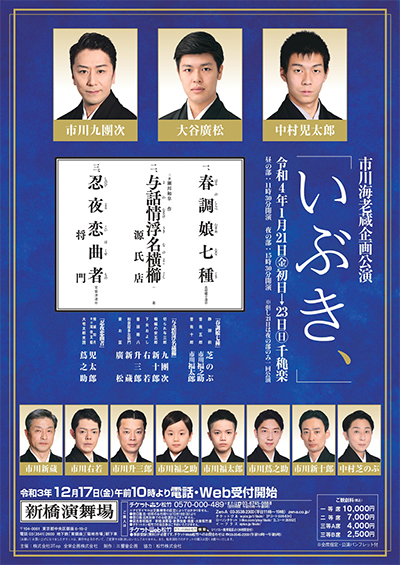 |
|
|||
| Dates | Shinshun Asakusa Kabuki New Year Asakusa Kabuki |
||
| MatinÚe |
??? |
||
| Evening |
??? |
||
| Casting |
??? |
||
| Comments |
The yearly show for young promising actors at the Asakusa K˘kaid˘ in Asakusa, a lively and colorful neighboorhood that keeps the scent of old Edo, has been cancelled due to the COVID-19 crisis. |
||
| Misonoza (Nagoya) |  |
| Dates | 30 ~ 31 January 2022 Ichikawa Ebiz˘ Shinshun Tokubetsu K˘en Ichikawa Ebiz˘ New Year Special Performances |
| Program |
Okina Senzai Sanbas˘ Otokodate Hana no Yoshiwara |
| Casting | |
| Comments |
A 2-day New Year special program in Nagoya at the Misonoza starring Ichikawa Ebiz˘. |
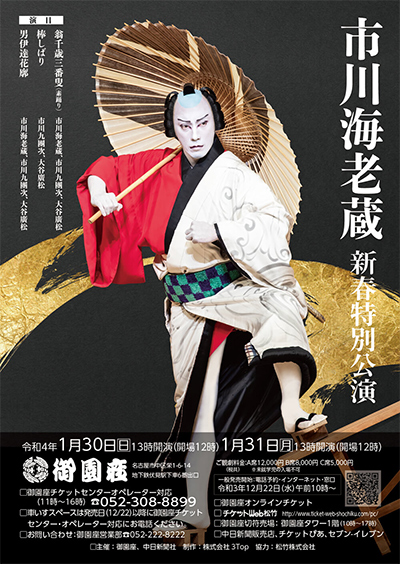 |
|
|
| Contact | Main | Top | Updates | Actors | Plays | Playwrights | Programs | Links | FAQ | Glossary | Chronology | Illustrations | Prints | Characters | Derivatives | Theaters | Coming soon | News |